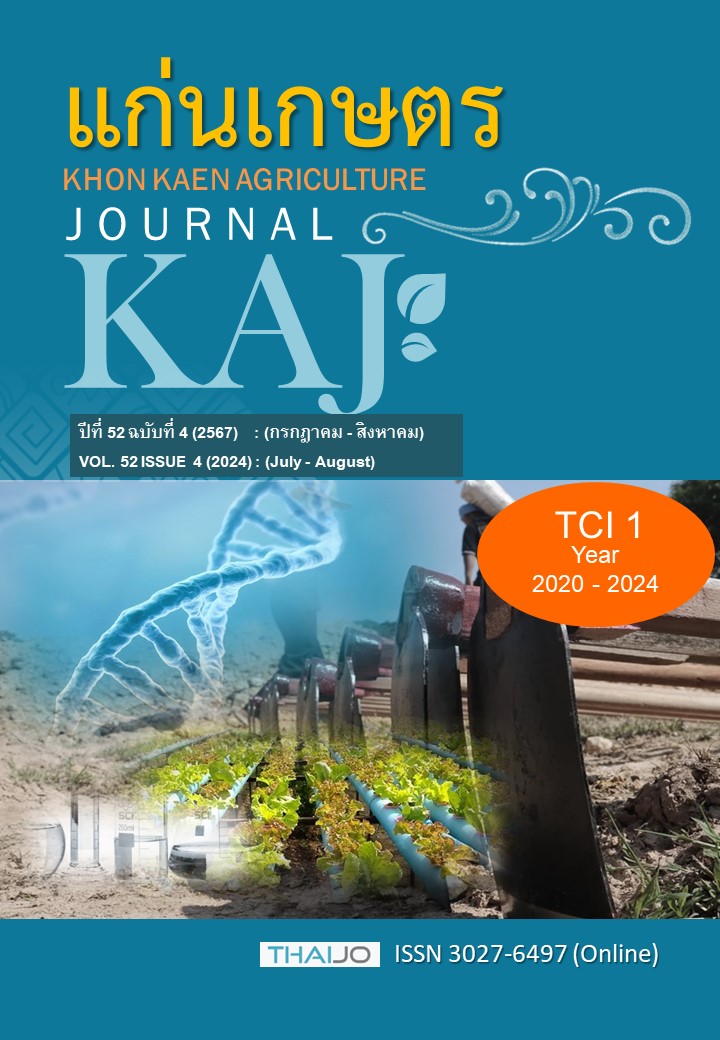Effect of Burma mahogany (Pentace burmanica Kurz) bark fermented juice on sex ratio and survival rate of Siamese fighting fish (Betta splendens)
Main Article Content
Abstract
This research aims to investigate the effect of Burma mahogany (Pentace burmanica Kurz) bark fermented juice on the growth, sex ratio, and survival rate of Siamese fighting fish (Betta splendens). A completely randomized design (CRD) was employed, with 6 experimental sets. These sets used fermented juice from the bark of Burmese mahogany with varying ratios: 0 (control), 0.25, 0.50, 0.75, 1.00, and 2.00 g/l. Each experimental set was replicated three times and conducted over a period of 60 days. It was found that the fermented juice made from the bark of Burma mahogany did not significantly affect the growth of Siamese fighting fish (P>0.05). However, there was a significant effect on the sex ratio (P<0.01). At 0.25 g/l, the highest proportion of males (68.95±8.67%) was observed, which was higher than the control (62.01±8.67%). However, as the concentration increased at the ratios of 0.50 and 0.75 g/l, there was a tendency towards a higher proportion of females compared to males, at 57.07±7.87% and 81.95±8.62%, respectively. At 1.00 and 2.00 g/l, all the fish were females (100%). Survival rates were not significantly different among all the experimental sets (P>0.05). At 0.50, 0.75, and 1.00 g/l, the survival rates of 99.33±0.58% were observed. Survival rates at 0.25 and 2.00 g/l were 98.67±0.58 and 98.67±1.15%, respectively, which were higher than the survival rate of the control (98.00±1.00%). Water quality analysis revealed that as the concentration of the fermented juice made from the bark of Burma mahogany increased, the pH level became more acidic (6.25-7.05) compared to the control (7.63). The alkalinity of the water was also lower (85 mg/l as CaCO3) compared to the control (200 mg/l as CaCO3). In conclusion, the fermented juice made from the bark of Burma mahogany does not affect the growth and survival rate of Siamese fighting fish.
Article Details

This work is licensed under a Creative Commons Attribution-NonCommercial-NoDerivatives 4.0 International License.
References
กรมป่าไม้. ม.ป.ป. สีเสียดเปลือก. สำนักงานความหลากหลายทางชีวภาพด้านป่าไม่. แหล่งข้อมูล http://www.rspg.org/rare_plants/ scien_name_p17.htm. ค้นเมื่อ 8 พฤศจิกายน 2564.
กิตติพงษ์ สุวรรณเกตุ. 2563. การเหนี่ยวนำให้เกิดเพศเมียในปลาหมอไทยโดยใช้สารสกัดหยาบกวาวเครือขาว. วิทยานิพนธ์ ปริญญาวิทยาศาสตรมหาบัณฑิต มหาวิทยาลัยราชภัฏรำไพพรรณี, จันทบุรี.
คุณนิธี ลีลารัศมี, สุทิพย์ ค้าของ และจักรพันธ์ สองสี. 2555. การแปลงเพศปลานิล (Oreochromis niloticus) โดยการแช่ลูกปลาระยะถุงไข่แดงยุบในสารสกัดใบมังคุดสด. วารสารแก่นเกษตร. 40 (ฉบับพิเศษ): 340-345.
ด่านตรวจสัตว์น้ำท่าอากาศยานสุวรรณภูมิ. 2563. สถิติการนำเข้าส่งออกสัตว์น้ำ ทางท่าอากาศยานสุวรรณภูมิ เดือนกันยายน 2563. แหล่งข้อมูล https://www4.fisheries.go.th/ local/file_ document/20201005164809_1_file.pdf. ค้นเมื่อ 8 พฤศจิกายน 2564.
ประภาส โฉลกพันธ์รัตน์. 2540. การเลี้ยงปลาสวยงาม. ภาควิชาประมง คณะเกษตรศาสตร์ มหาวิทยาลัยขอนแก่น.
พรพิมล พิมลรัตน์, นิวุฒิ หวังชัย, สุพันธ์ณี สุวรรณภักดี และพัชราวลัย ศรียะศักดิ์. 2560. เอกสารประกอบการอบรมสารสกัดแทนนินจากใบหูกวาง: วิธีการเตรียมอย่างง่ายและประยุกต์ใช้ในปลาสวยงาม. สาขาวิชาการประมง มหาวิทยาลัยแม่โจ้. ชุมพร.
มนต์ชัย ดวงจินดา. 2544. การใช้โปรแกรม SAS เพื่อวิเคราะห์งานวิจัยทางสัตว์. ปรับปรุงครั้งที่ 2. ภาควิชาสัตวศาสตร์ คณะเกษตรศาสตร์ มหาวิทยาลัยขอนแก่น.
ไมตรี ดวงสวัสดิ์ และจารุวรรณ สมศิริ. 2528. คุณสมบัติของน้ำและวิธีวิเคราะห์สำหรับการวิจัยทางการประมง. สถาบันประมงน้ำจืดแห่งชาติ, กรมประมง.
ศิริมา สุวรรณกูฏ. ม.ป.ป. สีเสียด สมุนไพรแก้ท้องร่วง. แหล่งข้อมูล http://www.phargarden.com/attachments/article-20101125154556.pdf. ค้นเมื่อ 8 พฤศจิกายน 2564.
ศิวาพร ศรีดาบุตร. 2549. ผลของการใช้น้ำสกัดใบหูกวางต่อการเพาะเลี้ยงปลากัด. วิทยานิพนธ์ปริญญาวิทยาศาสตรมหาบัณฑิต, สาขาวิชาประมง บัณฑิตวิทยาลัย มหาวิทยาลัยขอนแก่น. ขอนแก่น.
สมจินตนา พุทธมาตย์ และวรวัฒ สุวรรณสาร. 2550. การศึกษาองค์ประกอบทางเคมีของใบหูกวาง (Terminalia catappa L.) และผลต่อการเปลี่ยนแปลงคุณภาพน้ำและการยับยั้งแบคทีเรียในน้ำ. น. 579-585. ใน: การประชุมทางวิชาการของมหาวิทยาลัยเกษตรศาสตร์ ครั้งที่ 45, สาขาพืช, 30 มกราคม - 2 กุมภาพันธ์ 2550. มหาวิทยาลัยเกษตรศาสตร์, กรุงเทพฯ.
สุกสกาว รอดปั้น, นงนุช เลาหะวิสุทธิ์ และอัจฉรี เรืองเดช. 2563. ผลของความเป็นกรด-ด่างของน้ำจากใบหูกวางแห้งต่อการเพิ่มอัตราส่วนเพศผู้ และการเติบโตในปลากัดสายพันธุ์หางพระจันทร์ครึ่งซีก. วารสารเกษตรพระจอมเกล้า. 38(4): 511-518.
สุทิพย์ ค้าของ, คุณนิธี ลีลารัศมี, อัจฉริยา สุวรรณสัง และนิรุทธิ์ สุขเกษม. 2554. ผลของสารสกัดใบมังคุดต่อการผลิตปลานิลเพศผู้. แก่นเกษตร. 39 (ฉบับพิเศษ): 53-58.
อุไรวรรณ ไพชำนาญ และวัฒนา วัฒนกุล. 2544. ผลของสารสกัดจากใบมังคุดต่อการเปลี่ยนลักษณะเพศในปลากัด. คณะวิทยาศาสตร์และเทคโนโลยีประมง. สถาบันเทคโนโลยีราชมงคล. แหล่งข้อมูล https://www.repository.rmutsv. ac.th/bitstream/ handle/123456789/2048/FullText.pdf?sequence=1&isAllowed=y. ค้นเมื่อ 8 พฤศจิกายน 2566.
Balasubramani, A., and T.J. Pandian. 2008. Norethindrone ensures masculinization, normal growth and secondary sexual characteristics in the fighting fish, Betta splendens. Current Science. 95(10): 1446–1453.
Duangyod, T., C. Palanuvej, and N. Ruangrungsi. 2014. Pharmacognostic specifications and quantification of (+)-catechin and (-)-epicatechin in Pentace burmanica stem bark. Pharmacognosy Research. 6(3): 251.
Reddon, A. R., and P. L. Hurd. 2013. Water pH during early development influences sex ratio and male Morph in a West African cichlid fish, Pelvicachromis pulcher. Zoology. 116(3): 139-143.
Rodríguez De Luna, S. L., R. E. Ramírez-Garza, and S. O. Serna Saldívar. 2020. Environmentally friendly methods for flavonoid extraction from plant material: Impact of their operating conditions on yield and antioxidant properties. The Scientific World Journal. 2020: 1-38.
Rubin, D. A. 1985. Effect of pH on sex ratio in cichlids and a poecilliid (Teleostei). Copeia. 1985(1): 233-235.
Snedecor, G. W., and W. G. Cochran. 1967. Statistical Methods, 6th edition. Iowa State University Press.

